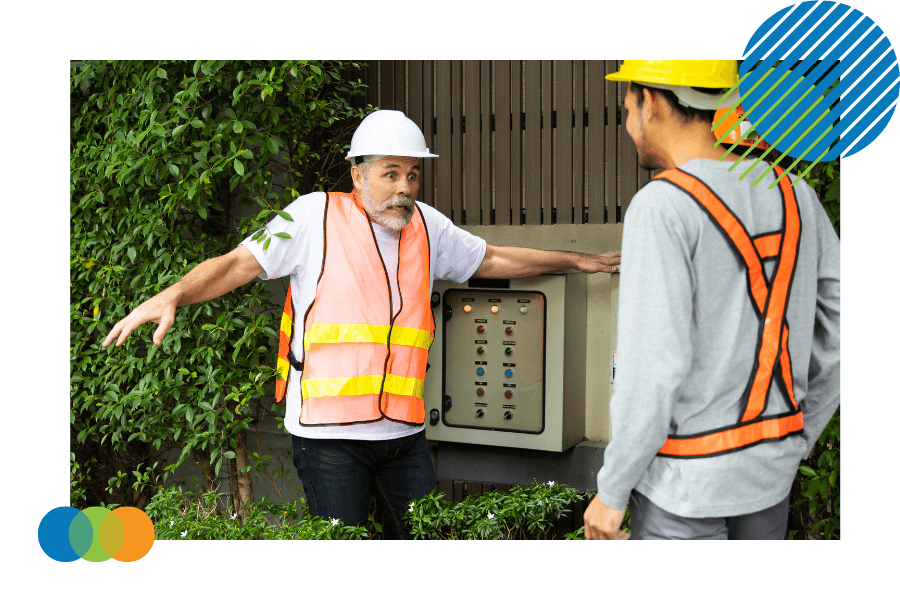 |
Written by Liz McDermott |
In the modern workplace, diverse age groups contribute to a rich tapestry of experiences, skills, and perspectives. This multigenerational workforce presents unique challenges and opportunities, especially in workplace safety. Tailoring safety protocols and training to meet the needs of different generations can significantly enhance overall safety outcomes and employee well-being.
This article delves into the intricacies of bridging the age gap in workplace safety, offering insights and strategies to create a safer and more inclusive environment for all employees.

Understanding the Multigenerational Workforce
The Generational Landscape
Today’s workforce comprises four primary generations: Baby Boomers, Generation X, Millennials, and Generation Z. Each generation has been shaped by distinct historical events, technological advancements, and cultural shifts, leading to different work ethics, communication styles, and safety perceptions.
-
Baby Boomers (1946-1964): This generation values stability, loyalty, and a structured work environment. They bring decades of experience and knowledge but may face physical challenges as they age.
-
Generation X (1965-1980): Known for their adaptability, Gen Xers are comfortable with technology and value work-life balance. They often bridge the gap between older and younger generations, blending traditional and modern work values.
-
Millennials (1981-1996): Growing up during the digital revolution, Millennials are tech-savvy and prioritize flexibility and purpose in their work. They tend to be proactive about health and safety, often advocating for a culture of prevention.
-
Generation Z (1997-2012): The youngest cohort in the workforce, Gen Zers are digital natives who value authenticity and inclusivity. They are particularly concerned about mental health and well-being in the workplace.
The Importance of Age Diversity
Embracing a multigenerational workforce can enhance creativity, innovation, and problem-solving. Each generation brings unique strengths that can contribute to a safer workplace. For example, older employees may have extensive experience in risk management, while younger workers may be more adept at utilizing technology to improve safety protocols.
Tailoring Safety Training Across Generations
Understanding Learning Preferences
Different generations often have distinct learning styles and preferences, which can impact the effectiveness of safety training programs.
-
Baby Boomers may prefer traditional, in-person training sessions with printed materials to reinforce learning.
-
Generation X often appreciates a combination of traditional and digital training methods, and they value flexibility in how they access information.
-
Millennials typically favor bite-sized, interactive digital content that allows for flexible learning schedules.
-
Generation Z thrives on engaging, visually stimulating training formats that utilize technology and social media.
Implementing Inclusive Training Methods
Organizations should consider a blended approach that combines various training methods to create effective safety training programs. This could include:
-
In-Person Workshops: For Baby Boomers and Gen Xers, traditional workshops can provide hands-on experience and foster interaction.
-
Digital Learning Platforms: Offering online courses and mobile-friendly content can cater to Millennials and Gen Z, allowing them to learn at their own pace.
-
Mentorship Programs: Pairing younger employees with seasoned veterans facilitates knowledge sharing and creates a supportive learning environment.
Communication Styles and Safety Culture
Adapting Communication Methods
Effective communication is crucial for promoting a strong safety culture. Different generations have varying preferences for how they receive information:
-
Face-to-Face Conversations: Baby Boomers and Gen Xers often prefer direct communication, such as meetings or personal conversations.
-
Digital Communication: Millennials and Gen Zers are more inclined to use text messages, emails, and social media.
Organizations should use a mix of communication methods to ensure that safety messages resonate with all employees. This could include:
-
Regular Safety Meetings: Incorporating in-person and virtual meetings can accommodate different preferences.
-
Digital Safety Bulletins: Utilizing emails or messaging apps to share safety updates and reminders can engage younger employees.
Bridging the Gap in Safety Protocols
Recognizing Physical and Mental Health Needs
Physical and mental health are integral to workplace safety. Employers should be aware of the unique health challenges faced by different generations:
-
Physical Health: Older employees may experience reduced mobility or chronic conditions that can impact their ability to perform certain tasks safely. Providing ergonomic solutions and flexible work arrangements can help accommodate their needs.
-
Mental Health: Younger generations, particularly Gen Z, report higher levels of stress and mental health concerns. Offering resources for mental well-being, such as counseling services and stress management programs, can foster a supportive work environment.
Creating a Proactive Safety Culture
A proactive safety approach involves identifying and addressing potential hazards before incidents occur. Employers can cultivate this culture by:
-
Encouraging Reporting: Create an environment where all employees feel comfortable reporting near-misses and safety concerns without fear of retaliation.
-
Implementing Regular Safety Audits: Conducting routine inspections and assessments can help identify areas for improvement and ensure compliance with safety regulations.
Leveraging Technology for Enhanced Safety
The Role of Digital Tools
Technology plays a vital role in modernizing workplace safety practices. Younger generations are often more comfortable with digital tools, which can streamline safety processes:
-
Mobile Safety Apps: Implementing mobile applications for reporting incidents, accessing safety resources, and conducting training can enhance engagement among younger employees.
-
Real-Time Monitoring: IoT devices and sensors can help monitor workplace conditions and alert employees to potential hazards.
Training on New Technologies
Organizations should provide comprehensive training addressing generational differences to ensure that all employees can effectively use new technologies. This could include:
-
Hands-On Training Sessions: Offering practical demonstrations for older employees can help them feel more comfortable with new tools.
-
Interactive Online Tutorials: For younger generations, engaging video tutorials can facilitate quick learning and adoption of new technologies.
Fostering Collaboration Across Generations
Encouraging Cross-Generational Teams
Creating opportunities for collaboration among different age groups can enhance workplace safety. Diverse teams can leverage their unique perspectives to develop innovative safety solutions.
-
Safety Committees: Forming committees that include representatives from all generations can ensure that safety initiatives reflect the needs and preferences of the entire workforce.
-
Team-Building Activities: Organizing activities encouraging teamwork and communication can help break down barriers and foster mutual respect among employees.
Celebrating Shared Successes
Recognizing and celebrating safety achievements can reinforce a positive safety culture. Organizations should:
-
Acknowledge Contributions: Highlight employees' contributions from all generations in safety initiatives.
-
Share Success Stories: Communicate success stories that demonstrate the impact of collaborative efforts on workplace safety.
Addressing Conflict and Misunderstandings
Navigating Generational Differences
While diversity can lead to innovative solutions, it can also result in misunderstandings and conflicts. Employers should be proactive in addressing potential issues:
-
Conflict Resolution Training: Providing effective communication and conflict resolution training can equip employees with the skills to navigate generational differences.
-
Facilitating Open Dialogue: Encouraging open discussions about generational perspectives can help employees understand each other better and foster a more inclusive environment.
Encouraging Empathy and Understanding
Creating an empathetic workplace culture involves recognizing and valuing the unique experiences of each generation. Employers can promote understanding by:
-
Sharing Personal Stories: Encouraging employees to share their experiences can help bridge gaps and foster connections.
-
Highlighting Common Goals: Focusing on shared objectives like workplace safety can unite employees across generations.
Continuous Improvement and Feedback
Establishing Feedback Loops
To ensure that safety protocols remain effective and relevant, organizations should establish feedback mechanisms that allow employees to share their insights and suggestions:
-
Regular Surveys: Conducting surveys to gather feedback on safety training and initiatives can help identify areas for improvement.
-
Suggestion Boxes: Providing anonymous suggestion boxes can encourage employees to voice their opinions without fear of judgment.
Adapting to Changing Needs
As the workforce continues to evolve, organizations must remain flexible and adapt their safety practices to meet the changing needs of employees. This may involve:
-
Revisiting Training Programs: Regularly reviewing and updating training materials to reflect current best practices and technological advancements.
-
Monitoring Industry Trends: Staying informed about industry trends and emerging safety technologies can help organizations remain competitive and proactive.
How Vubiz Safety Training Can Help Your Multigenerational Workforce
Bridging the age gap in workplace safety requires a thoughtful and inclusive approach to recognizing each generation's unique strengths and challenges. By tailoring safety training, communication methods, and protocols to meet the diverse needs of a multigenerational workforce, organizations can create a safer and more supportive environment for all employees.
Whether you are looking to prioritize safety as a shared responsibility by empowering every employee to contribute to a safer workplace for everyone or need to foster a safety culture of collaboration and continuous improvement, Vubiz's Multigenerational Workforce course will help you get started.
